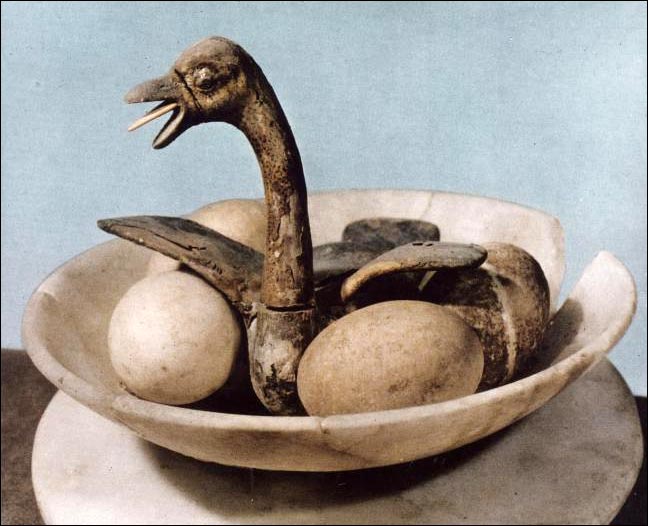 |
Jar Cover with Fledgling and Unhatched Eggs from Tomb of Tutankhamun Date 1347-1337 B.C., rein of Tutankhamun, Nebkheperure Artist n/a Origin The Ancient World : Egypt : New Kingdom : XVIII Dynasty : Amarna and Aftermath View other records from this era Summary The symbolism of the newly batched fledgling is employed in this objects perhaps to represent the inevitability of rebirth for the various spirits of the deceased king. Four eggs, suggestive of the completeness of creation, enhance the single young bird and create a naturalistic setting; presumably a vestige of the nature motifs of the earlier Amarna style in which similar devices seem to have represented the fullness of the created world under the control of pharaoh. Description Conceptualized as the lid atop a stone vessel, this scene presents a charming tableaux. In the center is young bird, wings outspread over the remaining broad, with its long neck turned to the side and its tongue protruding as if it were waiting to be fed. Confined withing a circular dish, vaguely reminescent of a nest, are two unhatched eggs on either side. Cultural Context A This is obstensibly a utilitanian object from the tomb of a deceased pharaoh. However, its rich imagery and delicate composition, indicate that it was intented to convey religious meaning. It is not known if this was especially made for funerary use or if it was used for ritual and ceremonial purposed during the lifetime of the kings. It is not even known if this was a standard type of either catagory. The care in its execution his various transformations after death. B In order to do this the motif of the egg filled nest and newly hatched fledgling is used. C This motif is rather rare in Egyptian art, occurring most frequently in the so-called "Fowling Scene." These scenes, originating in the Old Kingdom (cite), made use of a backdrop of a papyrus thicket which was a rich source of religious imagery. In the papyrus umbels and stalks, various birds and their nests are frequently depicted. Often they are being threatened by an ichneumen, and the mother bird is actively chasing the intruder away. "Fowling Scene" depict the "field of rushes" or a mythical, primeveal landscape emblematic of the disorientation of the recently dead. The deceased is shown boating through these mazes, often harpooning male hippopotami, a symbol of evil and chaos. The birds nest with fledglings represent-new life and the continuation of ma'at, or order. D This concept has been held to characterized the total stock of the annex of Tutankhamun's tomb, the room in which this vessel and lid was discovered. Order objects in this room include. However, it might be noted that several objects, which are clearly transformational and symbolic of rebirth, were not found here. An important example is the Osiris-bed of Tutankhamun, which was found in the treasury. Since the tomb was partially looted at two identifible incidents, and subsequently restored by the necropolis police, it would seen that the original contents of each room could be identified upon circumstancial evidence at best. E Goose, eggs etc F "As yet unborn the bird already chipps in the egg, For theu hast given it the breath of life, And set the time for it to break the shell, When it shall come fourth and loudly raise up its voice." Material or Technique Sculpture, alabaster (calcite) bird: painted wood with ivory tongue Measurement Diameter of lid: inches (13.4 cm) Provenance Egypt: Thebes, West Bank Necropolis, Valley of the Kings, KV 62, annex Repository or Site Egypt: Cairo, The Museum of Egyptian Art, Tutankhamun Catalogue #620 (1) Image Sources Desroches-Noblecourt, C. Tutankhamen, New York, 1963 color plate 47 |